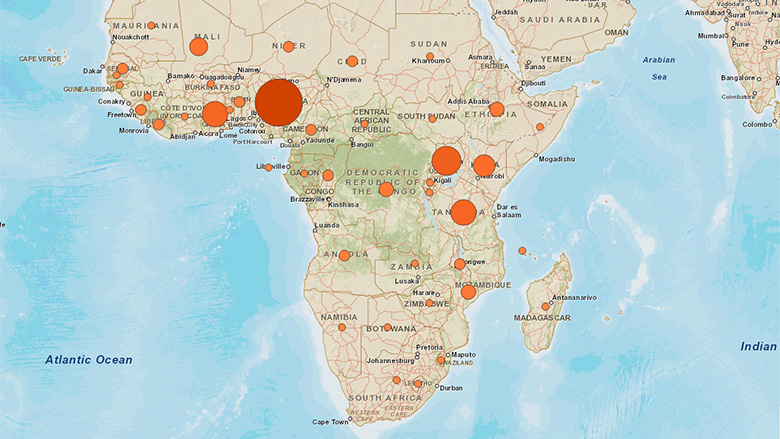Challenge
Eastern and Southern Africa are the only parts of the continent not connected to the global broadband network, creating prohibitive cost barriers to connectivity in a region that makes up only 0.07% of international bandwidth capacity. Reliance on expensive satellite infrastructure restricts the region’s capacity to compete in the global economy. In Kenya, one megabyte of bandwidth costs US$7,500, compared to a world average of US$200. These high costs and incomplete liberalization of telecommunications and information and communications technology (ICT) make it difficult for countries to create jobs, expand production of goods and services, and conduct trade. Specifically, incomplete liberalization of the industry has afforded incumbents monopoly power to keep prices high. Infrastructural impediments also abound, as 20 countries in the region lack direct terrestrial access to global information and communications infrastructure and networks. This makes communications service beyond urban centers extremely costly, further accentuating the urban-rural divide.
Solution
Africa’s Regional Communications Infrastructure Project (RCIP) contributes to lower prices for international capacity, extends the geographic reach of broadband networks, and improves government efficiency and transparency through e-government applications. RCIP’s first phase supports Kenya, Burundi, and Madagascar. The World Bank and the International Finance Corporation (IFC) open access initiative works to leverage private sector participation to improve connectivity across Eastern and Southern Africa. This initiative consists of undersea fiber optic cables and landing stations, the implementation of which is being led by the private sector, with funding from the World Bank, IFC, and other partners. Additionally, terrestrial networks are being developed to improve last mile delivery. The RCIP also invests in capacity building for target use groups such as governments and universities. An additional loan funded the development of an open access framework for infrastructure, open data activities, Integrated Financial Management Information System deployment, government services, and cyber security.
Results
As of December 2011, the RCIP had achieved the following results:
- Kenya’s volume of international traffic had reached 115,534 Mbit/s, up from 4,000 Mbit/s in 2007
- Access to telephone services in Kenya had reached 68% of individuals, up from 20.6% in 2007
- The price of wholesale international E1 capacity link in Kenya had dropped to $650/month from $7,500/month in 2007
- 314,978 Kenyans had directly benefited from the project
- Madagascar’s volume of international traffic had grown to 1,240 Mbit/s from 200 Mbit/s in 2007
- Access to telephone services in Madagascar had grown from 3% of the population in 2007 to 12% of the population, and 1.66% percent of the population had access to internet services, up from just 0.23% in 2007
- Burundi international traffic had reached 26,312 Mbit/s, up from 250 Mbit/s in 2007
- Access to telephone services in Burundi had grown from 6% of the population in 2007 to 43.8% of the population.
Mobile technology innovations and the liberalization of telecommunications markets have stimulated over $56 billion in private sector investment in Africa between 1998 and 2008, vastly increasing access to telephone services. Over the same period, the number of mobile phones in Africa has increased from less than 2 million to over 400 million.
The International Development Association (IDA) has contributed US$109.4 million to the project in Kenya, US$28.3 million in Madagascar, and US$18.8 million in Burundi. IDA was the only external financier of the RCIP.
Partners
The following eight development partners joined the World Bank in implementing the RCIP:
- The African Development Bank
- Agence Française de Développement (French Development Agency)
- The Development Bank of Southern Africa
- The UK Department for International Development
- The European Investment Bank
- The European Union
- KfW Bankengruppe (German development bank)
- The Swedish International Development Cooperation Agency.
Moving Forward
Additional countries will continue to be added to the project as it grows and expands. The nature of an Adaptable Program Loan involves a series of loans that allows other components to be prepared over time and be eligible for financing at subsequent stages. In the second and third phases, Rwanda, Malawi, Mozambique, and Tanzania will be brought into the project.
Beneficiaries
Neuti Nibruta, a student at the virtual campus of Universite Lumiere in Burundi, tells of the importance of connectivity for her own learning potential. “We connect using a ‘platform’ through which a professor from Canada gives the lecture, and we follow the course here in Bujumbura. Thus, Nibruta has the opportunity to earn a degree from the University Laval in Canada, while remaining in Burundi.
